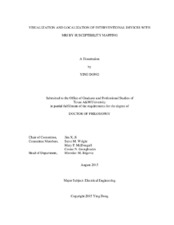| dc.description.abstract | Recently, interventional procedures can be performed with the visual assistance of MRI. However, the devices used in these procedures, such as brachytherapy seeds, biopsy needles, markers, and stents, have a large magnetic susceptibility that leads to severe signal loss and distortion in the MRI images and degrades the accuracy of the localization. Right now, there is no effective way to correctly identify, localize and visualize these interventional devices in MRI images.
In this dissertation, we proposed a method to improve the accuracy of localization and visualization by generating positive contrast of the interventional devices using a regularized L1 minimization algorithm. Specifically, the spin-echo sequence with a shifted 180-degree pulse is used to acquire high SNR data. A short shift time is used to avoid severe phase wrap. A phase unwrapping method based on Markov Random Field using Highest-Confidence-First algorithm is proposed to unwrap the phase image. Then the phase images with different shifted time are used to calculate the field map. Next, L1 regularized deconvolution is performed to calculate the susceptibility map. With much higher susceptibility of the interventional devices than the background tissue, the interventional devices show positive-contrast in the susceptibility image.
Computer simulations were performed to study the effect of the signal-to-noise ratio, resolution, orientation and size of the interventional devices on the accuracy of the results. Experiments were performed using gelatin and tissue phantom with brachytherapy seeds, gelatin phantoms with platinum wires, and water phantom with titanium needles. The results show that the proposed method provide positive contrast images of these interventional devices, differentiate them from other structures in the MRI images, and improves the visualization and localization of the devices. | en |


